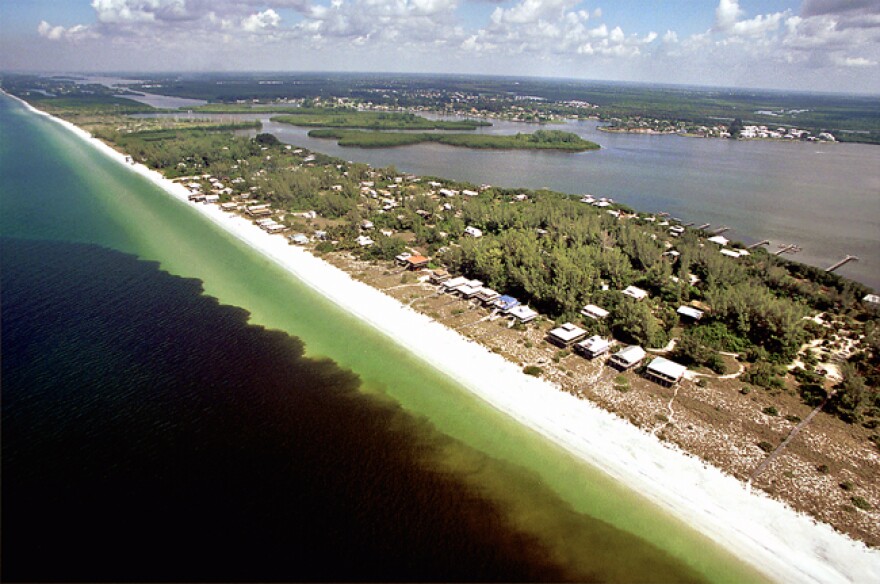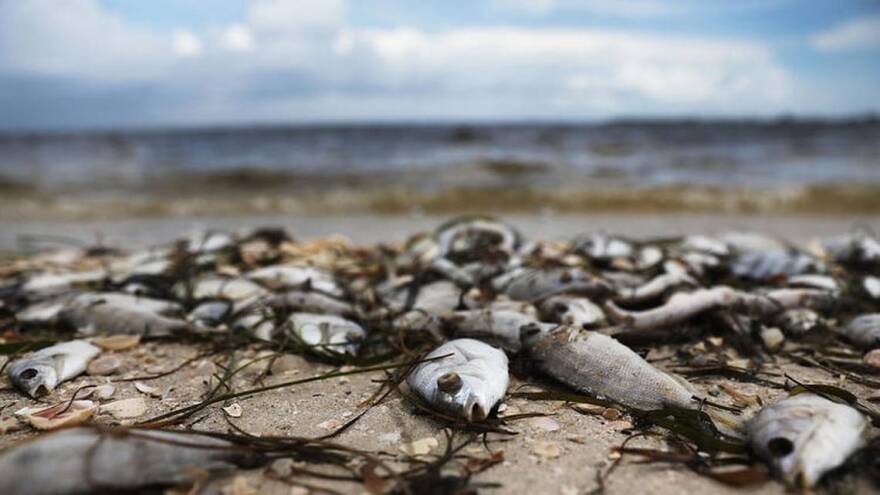New research documenting a grim connection between toxic red tides and ocean dead zones comes with an usual annotation: a poem.
The poem, composed by an English scientist, was inspired by a University of Miami study published this month in the journal Harmful Algae that found a third of Florida’s last 16 red tides overlapped with dead zones that leave the ocean depleted of oxygen. Those red tide algae blooms also started earlier in the summer and lingered into fall, suggesting temperature and ocean mixing play a role.
Or, in the words of the poem:
Creeping coils of rust
seep across the sea -
bands of coloured crud
buoyed by build-ups of
our chemical excess.
Red tide algae blooms have been a seasonal occurrence for centuries along the Gulf Coast. The algae live at the bottom of the Gulf, far offshore, and can bloom during the late summer and early fall. But when wind and water conditions carry it onshore, pollution from land can worsen it, triggering lethal blooms like a two-year tide that devastated Florida’s Gulf Coast between 2017 and 2019.
“We're starting to connect the dots between these different disparate events where we know the red tide is bad,” said lead author Brendan Turley, an oceanographer at the UM-based Cooperative Institute of Marine and Atmospheric Studies and Rosenstiel School of Marine and Atmospheric Science. ”Now we know there's also a connection between red tides and hypoxia. And hypoxia is really bad.”
The lingering tide coated beaches with dead marine life, including sturdy turtles, dolphins and tarpon, and shut down waterfront businesses. Another persistent and deadly red tide just a decade earlier wiped out a third of the Gulf’s red grouper population, the study said.
For the study, the researchers combed through data on ocean conditions compiled by the National Oceanic and Atmospheric Administration between 2004 and 2019 to locate areas with low oxygen levels and red tides. They found the two coincided during five years and always near shore in waters less than about 165-feet deep.

While the duration of the blooms played a part, the lack of ocean mixing that can occur when surface waters heat up also contributed, Turley said.
“The length of the red tide definitely has an effect, but also the stratification, that really strong difference between the surface and bottom temperatures,” he said. “The persistence and prolongation of that event can also really contribute to these red tides and the dead zones themselves.”
That’s because as red tide algae die, they sink to the ocean floor where they begin decomposing, which absorbs oxygen. When the ocean stratifies, usually when surface temperatures heat up, less oxygen gets into the water because there’s no mixing between layers. That leaves the dead zones and ocean life struggling without oxygen.
Understanding how the two potentially catastrophic events overlap is needed to better manage valuable fisheries, like red grouper and stone crab, in the Gulf, Turley said.
“It's still kind of a budding science to really understand the magnitude of mortality to these events to the fishery,” he said. “But it speaks to some of the larger ecosystem processes that really impact fisheries.”
And something Edinburgh University associate professor Sam Illingworth thought needed to be put in less academic terms.
Illingworth is a scientist who has focused his research and work on trying to better communicate science. He’s also a poet.

“As a 14-year-old British boy, I thought I was going to be the next Shelley or Byron, which obviously is not maybe quite a good thing. I've not died of syphilis yet. But then I did my PhD in atmospheric physics,” he said.
He’s written poems about research on the decline in basking sharks, the link between green spaces and healthcare costs, processed foods and aphantasia, a kind of blindness that prevents the brain from creating visual imagery.
“I guess I bring interesting, bizarre, strange, inspirational research to people in a language that they may be more familiar with,” Illingworth said.

The red tide paper stood out, he said, because it was both well-documented and well-written. It also tugged at his heart strings: Illingworth has taken a lot of family vacations in Florida.
“My mom's been to Disneyland 15 times. It's kind of crazy,” he said.
Besides being clear and concise, the study offered a poetic perk: imagery.
“It’s very visual, isn’t it?” he said. “I was like red tides, dead zones. There’s a nice shift there.”
Illingworth included the poem in his April podcast as well as his blog at thepoetryofscience.scienceblog.com.
As climate change warms ocean temperatures and produces more rainfall that can pollute inshore waters with pollution, Turley said scientists suspect these overlapping events could become more common. The researchers have proposed looking at the links for another study, he said.
That's another interest the two scientists share. As anxiety over climate impacts deepens, Illingworth said he has expanded his research into finding ways to better empower people.
"We can lose sight of what we can do as individuals," he said. "One of the great things that science communication does is to not necessarily tell people how to think, but rather [educate] them with the facts and the tools that enable them to process and assimilate that information and then make their own decisions."



